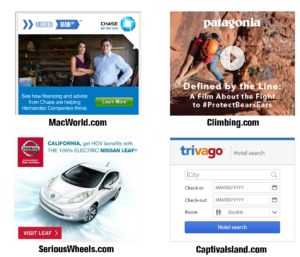Jump to section
5 best practices for the Google Display Network
The Google Display Network (GDN) has been poo-poohed by some digital marketers because it’s not as effective at direct response as its AdWords cousin, paid search, and it doesn’t feature the targeting or programmatic buying capabilities of brand-awareness platforms like Facebook or DSPs. So, should you ignore the GDN? Emphatically: no. If you haven’t had success with the GDN in the past, it might have less to do with the platform and more to do with some campaign-management mistakes. With that in mind, let’s review 5 GDN best practices that can put you on the path to ROI-positive success.
1. Know Your Goals
Sure, the GDN can get you some direct-response conversions, but the platform has different strengths – so before you pour in money, figure out what you’d like to accomplish.
- More volume?
- Lower overall CPA? (Note that a good attribution strategy is key to learning the GDN’s value here)
- Cheaper traffic?
- Fuel for a retargeting strategy in place to re-engage your site’s visitors?
2. Know Your Audience
The GDN does have a bunch of targeting options (which we’ll get to in a second). To make full use of those, though, you’ll need to have a good idea of who your audience is. Who’s your target customer? This breaks down into:
- Age
- Gender
- Interests
- Location
- Problem your service or product is trying to solve
- Income level
In other words, if you’re UrbanSitter.com, and your target is a city-dwelling mom in her early 30s who enjoys dining out but has very little free time and/or child support, you’ve got yourself some fine-tuned targeting options. Which brings us to…
3. Know Your Targeting Options
The GDN allows you to target by:
- Contextual
- Placement
- Topics
- Interests
- Remarketing
- Gender
- Age
Age, gender, interests, and topics are pretty self-explanatory. Placement targeting means that you can put your ads on the exact sites – or even specific pages within a site – where you’d like them to appear. This works well in conjunction with contextual targeting, which allows you to target by keywords. For instance, let’s say you use placement targeting to put your ads on RaisingaToddler.com (yeah, I made that up), but you’d like your ads to appear only where the words “Chicago” or “Windy City” or “Second City” appear because you’d like to create a campaign targeted specifically to Chicagoland moms. That’s pretty decent targeting capability, no?
4. Have a Retargeting Strategy
Since retargeting has quickly become every digital marketer’s most indispensable tool for improving ROI, you need to make sure you have a retargeting strategy in place before you start bringing traffic (which you can then retarget) to your site. Note: Retargeting is available through the GDN, Remarketing Lists for Search Ads ( also on AdWords), the Facebook Exchange, or other display channels. There’s a ton of good thought leadership on retargeting out there, but let me recommend our own whitepaper, the Complete Guide to AdWords Remarketing, available by filling out the download form here, for a thorough rundown of all the options available to you in the AdWords platform.
5. Make Your Ads as Clear as Possible
Remember, folks on the GDN haven’t asked to see your ads, so they’re going to have very little inclination to try to figure out what your ad is about. If you use a text ad, spell it out. If you use an image ad, make sure the image is recognizable and pertains directly to your product or service (if you’re advertising a product, show the product!). Here’s a great example of a clear ad, found on Runner’s World:Free shoes? Sign me up…and get me into your system, at which point you can retarget me with more display ads and email me all sorts of fun coupons, specials, etc. So there you have it: some GDN basics that should have you convinced to either give the platform another go…or fine-tune the campaigns you’re already running. Good luck!

Google Display Ad Network Examples
To support the best practices listed above, The Search Monitor updated this post in June 2015 with examples from a few leading display advertisers. Using our Display Ad Monitoring platform, we searched the Google Display Ad Network for ads featuring high-quality imagery and compelling calls-to-action on a variety of publisher sites. And we looked for advertisers that were skilled at adjusting creative and messaging according to each publisher. Here are four examples from Chase, Patagonia, Nissan, and Trivago that we wanted to highlight: These ads are simple, effective, engaging display ads that we saw consistently on multiple publisher sites (sometimes they ran as long as three years!). There are, of course many more examples, but we especially liked these four. Hopefully you’re currently monitoring the display ads of your competitors and leaders in your industry, to borrow their best practices and make sure your ads stand a competitive chance of being clicked. There’s no end to what you can learn from image ads like these (and Flash ads, which we also collect!). If you’d like to know more about Google Display Network creative or targeting strategies for these advertisers or any others, contact The Search Monitor or request a demo of our display ad monitoring service.
These ads are simple, effective, engaging display ads that we saw consistently on multiple publisher sites (sometimes they ran as long as three years!). There are, of course many more examples, but we especially liked these four. Hopefully you’re currently monitoring the display ads of your competitors and leaders in your industry, to borrow their best practices and make sure your ads stand a competitive chance of being clicked. There’s no end to what you can learn from image ads like these (and Flash ads, which we also collect!). If you’d like to know more about Google Display Network creative or targeting strategies for these advertisers or any others, contact The Search Monitor or request a demo of our display ad monitoring service.
Share on Social
See Our Data at Work
Provide us with a competitor’s website, a set of keywords, or one of our 1,000+ verticals, and we’ll show you the power of our monitoring capabilities. Request a personalized demo today and see what our insights can do for you!
Trusted by







 Brand Protection
Brand Protection SEM Insights
SEM Insights Affiliate Compliance
Affiliate Compliance Ad Armor
Ad Armor Learning Center
Learning Center Guides & Webinars
Guides & Webinars We Love Data™
We Love Data™ About Us
About Us Our Data
Our Data Careers
Careers Our Team
Our Team News
News Contact Us
Contact Us
